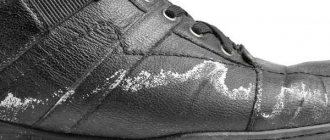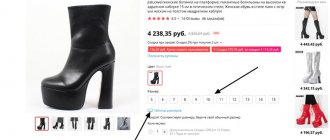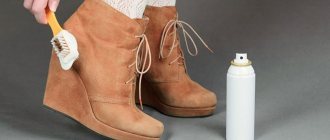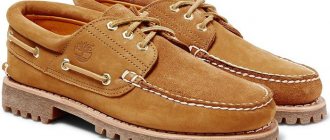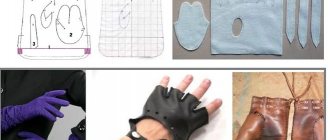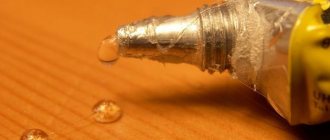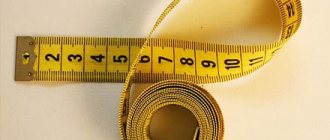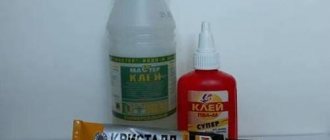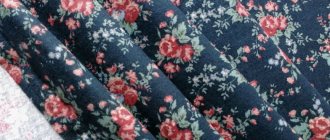The attractive appearance of a new pair of shoes is lost over time during use. One of the problems that arises is creases and folds.
This is not only an aesthetic defect, but also a factor that contributes to faster wear. There is a need to remove creases and restore the appearance of the pair.
We will tell you in this article how to remove creases from leather, suede, faux leather, and nubuck shoes.
Causes of the problem
The new shoes have a sleek upper and an attractive look. When walking, the leg in the foot constantly changes position, which leads to the appearance of bends on the surface. Even an expensive branded pair is not immune from this. But deep creases do not always occur.
The following factors contribute to this circumstance:
- low quality of the product (tailoring and materials);
- incorrectly selected size or model;
- violation of storage rules;
- wearing a pair in the wrong season for which it is intended;
- improper use and care.
The factor that contributes to the appearance of folds may be the model itself.
If a single piece of leather was used for manufacturing, then creases at the bend of the foot are more likely to appear than on shoes that were sewn from several small fragments, highlighting the toe. Another factor is incorrect selection of size and fullness. Creases appear more often in cases where:
- The last is too wide and the foot does not fit properly.
- The block, on the contrary, is too narrow, which leads to tension in the upper material that was not intended by the manufacturer.
Most often, creases form on shoes without heels, since in such a pair the foot bends more when walking.
How to “put” creases correctly?
If you've just bought new shoes or boots, we recommend that you try adding creases to them yourself to make them look as attractive as possible. This trick can be especially useful if you realize that the shoes don't fit very well in terms of fit and/or fit, but you don't want to return them to the store.
Creating creases with pencils
To carry out this procedure, you need to arm yourself with two pencils or sticks with a smooth surface, similar to pencils. Put the shoes on your feet, tie the laces on them and take these pencils (or sticks) in your hands, holding them with your fingers parallel to each other. Then press with these sticks on the place of the front (vamp) where you would like to see the crease/creases. Then move your foot and bend it smoothly. If necessary, slightly change the position of the sticks (pencils), press them again on the vamp and bend the foot again. If the position of the sticks turns out to be optimal, bend your foot a couple more times. After this, carry out the same procedure with the second shoe.
How to fix the defect?
If a defect appears on your favorite pair, you need to take action to fix the problem. It is advisable to start working at a stage before the creases become too strong and noticeable. It is easier to eliminate shallow folds than large creases.
Shallow
Homemade recipes will help you cope with a problem that has just arisen. They are not difficult.
Paper and cream
In order to remove only emerging wrinkles, you must perform the following steps:
- Stuff the toe of the pair tightly with crumpled paper, socks, or insert spacers to straighten the surface.
- Apply shoe polish, paying attention to problem areas.
- Leave the steam until the cream dries.
- Clean up.
- Remove the stuffing.
Wax and tinting
If the dents are small at the bend, you can use shoe wax. This product will soften and nourish the surface. Tinting is also suitable. But a good effect will only be achieved if the product is selected very accurately in color.
Cream
An emollient cream will help remove emerging creases.
Procedure:
- Lubricate the surface of the shoes with cream.
- Leave for a quarter of an hour.
- Stuff the sock tightly with paper.
- Place the pair on their side.
- Continue treatment 2 times a day for 3 days.
- After the bend has straightened, the remaining cream must be removed from the surface with a napkin.
- Apply shoe wax.
- Clean up.
- Remove the paper.
Deep
In cases where the problem has worsened and the fold has become pronounced, more complex methods of influence will have to be used.
You need to prepare the following tools in advance:
- iron;
- cloth napkin (preferably microfiber);
- water;
- paper for stuffing (or special pads).
Work order:
Stuff the toe of the shoe with paper.- Moisten the cloth with water and wring it out.
- Place the napkin on the area with the crease, pressing firmly against the skin.
- Leave for a few minutes until the surface of the skin becomes slightly moisturized.
- Turn on the iron and set the heat to medium.
- Gently iron the crease area with a cloth.
- Leave the steam to stand until completely dry.
- Remove paper.
- Apply cream or wax to the surface.
- Carry out high-quality cleaning.
The sole of the iron should not be allowed to come into direct contact with the surface of the shoe; treatment is only permissible through the intervening fabric.
The process of processing shoes with creases can be seen in the video:
Fatty, shiny spots
Removing stains from suede shoes is much more difficult. But there are chemicals and folk remedies that help effectively deal with unsightly salt stains.
Cleaning products
There are many ways to restore the attractive appearance of suede. You can remove salt stains from shoes at home using industrial chemicals and folk methods.
Specialized suede care products can remove salt stains from the material, while simultaneously preventing re-contamination the next time you go outside:
- Foam Combi Cleaner Salamander is a universal cleaner for leather, suede and textiles with lime oil, which can remove dirt, water stains, salt, and restore color. Apply using a napkin or sponge. After treatment with foam, the pile is treated with a special brush.
- Saphir Omni DAIM is a liquid with an enhanced formula for cleaning suede. Removes even old stains and stains, restores color. The pile is treated with a brush soaked in liquid, then with a sponge.
- DE SALTER Tarrago – removes stains and stains, neutralizes absorbed salt. The product is applied with a sponge attached to the bottle.
- Solemate Cleaner is a universal cleansing shoe shampoo. A small amount of the product is foamed with a sponge, then applied to the surface. After 5-7 minutes, remove excess with a damp cloth.
- NUBUCK CLEANER – spray for cleaning nubuck and suede. Nourishes, refreshes color, cleanses. Does not contain solvents.
Traditional methods
In the absence of special and quite expensive means to clean boots from stains, you can use folk recipes:
- Ammonia is diluted with water in a ratio of 1:5. Soak a sponge in the solution and clean the surface of the shoes in a circular motion. Then the surface is wiped with a solution of 1 tablespoon of vinegar in a liter of water. The solution will quickly remove fresh white stains.
- A soft brush is soaked in vinegar (9%) and white spots are removed. Then the surface is wiped with a damp cloth. Vinegar is also used to treat those places on suede shoes that begin to shine.
- 1 tablespoon of liquid soap is dissolved in 250 ml of water, 0.5 teaspoon of ammonia is added and the mixture is foamed. The resulting foam is applied with a sponge for several minutes. Residues of soap are cleaned with a damp sponge. Finally, the surface is cleaned with a brush soaked in vinegar.
- Light-colored models are cleaned with tooth powder. It is poured onto the surface, especially thickly on heavily polluted places, and left for an hour. The powder absorbs the salt and is then brushed off.
- Stains are wiped with dry crust of rye bread or raw potatoes. After cleaning, the surface is treated with a sponge.
- Special purified gasoline purchased at a hardware store. Moisten a cotton pad with gasoline and wipe off the stains. The treatment should be light and superficial, otherwise gasoline will dissolve the paint and stains will remain on the shoes.
- Fresh salt stains are evaporated over boiling water. Each boot is stuffed with newspapers and held over steam for 5-6 minutes, while simultaneously brushing off the soaking salt. When steaming, it is important not to overdo it. Processing for too long will lead to deformation of the shoes.
Suede shoes can suffer not only from winter reagents, but also from other types of pollution. Any dirt must be removed as quickly as possible, without waiting for it to dry. It will be much more difficult to deal with a well-absorbed, dried stain.
There are specific cleaning methods for each type of stain:
- Grass marks often appear on suede sneakers. Remove green grass from sneakers with a salt solution.
- Flower stains are removed with gasoline, then wiped with ammonia.
- The blood is washed off with a stream of water from the tap. Then the washed area is treated with a soap solution.
- Rust or other yellow spots are removed with a cotton pad soaked in lemon juice.
- Wax that accidentally gets on shoes is removed with a blunt object. Traces of wax are erased with gasoline.
- If chewing gum gets on the suede, place the shoes in a plastic bag and put them in the freezer. After a few hours, the chewing gum is cleaned off, and the traces of it are removed with gasoline.
- Wine stains are blotted with a napkin, then washed under running warm water.
- Shiny areas are treated with fine-grained sandpaper. Before treatment, the surface is slightly moistened with ammonia. Rub the shiny stain in one direction, with light pressure.
- Grease is effectively wiped off with pure gasoline. After treatment, sprinkle the greasy area with talcum powder, then clean it with a brush.
- After cleaning the stain, the pungent smell of gasoline is removed with a soap solution to which a few drops of ammonia are added.
We suggest you read How to quickly break in tight shoes
Suede is an attractive and comfortable material to wear. Products made from it look elegant and luxurious. However, this material requires special care.
Suede seems to many people to be impractical and short-lived, as it requires careful care. If used incorrectly, the material becomes worn, shiny and loses its original appearance.
What is suede made from?
How to properly clean suede products
How to quickly remove a stain
Proper care of suede
Suede shoes have been especially popular in the last few seasons, which is why leading designers advise fashionistas to get them. If you follow the rules of cleaning, drying, and caring for suede shoes, you can maintain their attractiveness.
First of all, you need to determine what the material consists of. It should be noted that suede is divided into natural and artificial. All types of suede are used in the production of clothing, shoes and haberdashery goods.
Important
The natural material is made from animal skin, processed using a special technology - fat tanning. Its distinctive qualities are softness, velvety, viscousness and subtlety.
Almost in no way inferior to natural suede is artificial suede, which is made from modern materials.
The structure of the material has a fine pile, easily absorbs moisture, after which it swells and becomes rigid. Therefore, it needs careful and careful care.
However, in everyday life, various troubles arise (someone may step on, touch, or spill), after which contaminants are formed that are difficult to remove later.
Of course, in such a situation the question arises: how to clean suede products at home?
It should be immediately noted that this material does not tolerate moisture, so it is better to clean suede using dry products and methods.
If there are minor stains, you can try to remove them with a special eraser that is gentle on the suede surface. An alternative to a special eraser can be a simple rubber band.
If there are old or deep stains, the item can be dry cleaned.
Now there are several methods of dry cleaning, which are selected based on the materials used in the production of products (leather and suede, fur and suede, etc.). The most well-known method for removing complex stains is dry cleaning with perchlorethylene.
Advice
When using this toxic substance, you must follow safety rules and use special equipment. Sometimes cleaning can remove the water-repellent layer and paint, so it can be used in extreme situations. The most harmless type of dry cleaning is removing stains with hydrocarbon solvents.
The disadvantage of this method may be its low efficiency in dealing with heavily contaminated material.
For those who want to know about cleaning suede at home, some recommendations are given.
The optimal folk cleaning method is a mixture of soda and skim milk (a teaspoon of soda is added to a glass of milk). But this may leave white spots on the surface that can be painted over.
An effective means of removing dirt from a suede surface is a 10% ammonia solution, which can be replaced with soda (add ¼ cup of ammonia to ½ cup of milk).
Wipe the dirty area with a cloth moistened with liquid.
Light suede products are cleaned with white bread crumbs. To do this, rub the dried stain with a dry crust of bread, a rubber brush or fine sandpaper. There is no need to press or rub too hard. After treatment, comb the pile with a brush.
Heavily dirty light-colored items should be wiped with a napkin soaked in a solution of powder or soap with ammonia (20 grams of powder or soap flakes and a few drops of alcohol per 1 liter of water). After this, the surface must be washed with water and dried.
Please note that it is not advisable to get suede items too wet. Grease stains are removed with gasoline.
note
Suede gloves can be cleaned from dirt with simple toilet soap. Put them on your hands and treat the dirty areas with dry soap.
After this, you need to rinse the gloves with warm water and lay them out to dry, but not the battery.
If after drying they have become rough, you can give them softness and initial fluffiness using a vacuum cleaner or a clothes brush with hard bristles. White suede should be dried on a towel.
If shiny spots form, sprinkle them with starch, wait 30 minutes and clean with a dry fluffy brush. If after such treatment the contamination does not disappear, it is necessary to dilute the starch and ammonia, and then apply the resulting solution to the surface. After the treated area has dried, the starch can be removed with a fluffy brush.
During wear, suede products (especially folds) form creases. Lint jams may often occur. In this case, the item must be steamed using a simple iron or a bowl of hot water. The item must be held over steam, and then combed using a clothes brush with hard bristles.
The main thing is not to keep the products over steam for a long time, otherwise they can become very rough.
Contaminated ugg boots or shoes should be cleaned with a solution of soap and ammonia. Then you need to treat with a water-repellent spray. It can be bought at any store. Suede products can be cleaned with a brush, which must first be dipped in coffee grounds.
What to do with leatherette?
Artificial leather is significantly different in structure from natural leather, despite its external similarity. You should not use recipes that are suitable for natural materials for dermantin and eco-leather, as they will not be effective.
The artificial material does not contain fibers that can expand when softened with waxes and oils. Therefore, shoes with non-natural uppers must be taken care of regularly and thoroughly.
If the rules of storage and wearing are violated, the creases quickly become deep and practically irremovable. Leatherette shoes should be stored with inserts or lasts , avoiding even slight deformation. It is also necessary to use special care products.
How to smooth suede and nubuck?
On suede and nubuck, folds may appear already in the first season of wearing shoes. But even on such complex material it is quite possible to eliminate defects.
To bring such a pair back to normal you will need:
- a special brush for suede with rubber bristles;
- damp cloth;
- hairdryer
Procedure:
Clean the surface from dirt and dust.- Insert the filler so that the outer surface of the shoe upper is smoothed.
- Carefully walk over suede (nubuck) with a special brush.
- Place a piece of damp cloth on top of the problem area.
- Turn on the hairdryer.
- Direct a stream of heated air onto the fold.
- Remove the rag.
- Let the shoes dry naturally.
Instead of a brush, you can use fine-grained sandpaper, but you need to use it even more carefully so as not to damage the pile.
Prevention measures
In order to preserve the appearance of your shoes for as long as possible and avoid creases, you should adhere to the following preventive measures:
- If expensive dress shoes are intended to be worn only indoors, they should not be used outdoors.
- You should put on a pair using a shoe horn.
- Natural materials (leather, nubuck, suede) must be protected from frequent contact with water.
- You need to put on your shoes after first unfastening the clasp.
- It is recommended to have at least 2 pairs of shoes for the season, and wear them every other day, giving each pair the opportunity to dry and air out. Otherwise, due to constant moisture and incomplete drying, the pair will last less.
- Shoes should be cleaned after every use outside.
- Do not use soap or aggressive cleaning agents to care for natural leather.
- It is recommended to dry shoes in a room with good air exchange.
- Cream and wax should only be applied to dry and clean shoe surfaces.
- Do not wear shoes that are not completely dry.
- Shoes should be stored after having been stuffed with paper in conditions where deformation is excluded. The best option is right in the box.
- If your shoes get too wet, they can lead to deformation of the upper, creases, and even cracks.
Timely proper care of shoes will extend their service life and preserve their appearance for a long time.
How to refresh the color of your shoes
Wearing suede shoes for a long time causes them to fade and become less bright. In this case, it is quite possible to restore the color at home. Rub brown shoes or boots well with coffee grounds. Let them sit overnight and then remove any remaining product.
Light-colored shoes (white and milky) can be refreshed with talcum powder or chalk. Follow the same principle. Rub the suede thoroughly and then shake off any excess. Lift the pile with a brush.
For black shoes, use special dyeing compounds. They are sprayed onto clean shoes and dry within a few hours.
Before and after
If you have colored suede, then you can restore the brightness of its color only in a workshop.
Sometimes, even with good care, suede shoes fade in the sun. Color brightness also decreases with prolonged use. There are several ways to restore the original color and refresh suede products:
- Special coloring spray. The shade of paint should match the color of the shoes. This paint can be purchased at shoe stores or in the household chemicals department. It must be used strictly in accordance with the instructions. Before painting, it is important to cover the floor or other surface on which the shoes will sit.
- Ground coffee. Shoes of dark shades can be treated with brewed natural coffee. The prepared drink must be filtered through a strainer. Pour the liquid into a spray bottle and spray over the suede surface. After 20 hours, the solution will be completely absorbed. If the color is not saturated enough, you can repeat the coloring.
- Soda and milk. A product made from 0.5 cups of skim milk and 0.5 tsp will help refresh the color. soda ash. The solution is applied to faded areas.
- Marker. You can return the black color using a regular marker. It is better to take waterproof markers so that the paint does not wash out again.
Recommendations
Expert advice will help you cope with the task quickly and without problems:
Before removing creases, shoes must be cleaned of dust and dirt.- You should purchase shoes in accordance not only with the size, but also with the appropriate fullness.
- In cases where you can’t deal with creases on your own, or you don’t have time for this, you can turn to a shoe workshop for help.
- You should not use shoe care products immediately before going outside. This must be done in advance so that the cream has time to absorb and act.
- For removing creases, silicone-based products are less effective than wax-based products. This is due to the fact that silicone does not moisturize the surface, but only gives it shine.
- The purchased shoe care products must match the shoes not only in color, but also in the texture of the material. Information about this is present on the packaging. For example, “for smooth leather”, “for nubuck”, etc.
Tips for care and prevention
Before putting on new suede shoes, treat them with a special protective spray.
Use the product according to the season. For winter, autumn and early spring it is better to use water-repellent sprays. They allow the suede to remain dry even on very wet roads. In addition, after the sole and upper material dry, the suede remains beautiful and fleecy. For summer shoes made of special leather, it is better to use dust-repellent compounds. They preserve the brightness of a black product and the freshness of light-colored shoes. After treating the suede with the spray, let it sit for at least three hours and only then put on your shoes. Renew the spray layers periodically approximately once every 2-3 weeks or as appropriate.
Interesting: How to clean a greasy sofa
To ensure that your boots, boots or sneakers, or suede shoes last as long as possible, follow these rules for caring for them and storing them:
- In the off-season and between socks, keep suede shoes in a dark place. It is better in factory boxes or specially equipped dressing rooms. Suede does not like sunlight.
- To care for the material, use only specially designed compounds. Products for smooth skin are not suitable at all.
- Never wash suede under any circumstances. Water spoils its appearance.
- Periodically, even if you do not wear suede shoes, ruffle their pile. Otherwise, it will simply stick together over time and lose its noble attractiveness.
- If your shoes get wet in the rain, dry them only naturally at room temperature. It is forbidden to dry suede near a radiator, air heater or other hot heating appliances. Sudden drying leads to hardening of the skin. She loses her appearance.
Interesting: How to quickly clean a microwave
Proper care of boots, shoes, boots and knowledge of how to clean suede shoes at home will allow you to have beautiful products for every day and for special occasions.
What do you use to clean suede?
To restore the canvas and give it its original appearance, the following tools will be required:
- Eraser. Using it, you can eliminate scratches on suede shoes, raise the pile and improve the color. You can use both regular stationery and special ones for products made from this material.
- Brushes. Their range varies depending on the material and type of pile. There are 3 main types: metal (for old worn surfaces), polymer and rubber (for new products). The effect is achieved by raising the pile, which gives it a more noble appearance and eliminates various contaminants.
- Specialized sprays of two types: for protection and painting. The latter are able to restore the color of suede shoes by dyeing them to the desired shade. The most common colors are black, blue and brown. The colorless protective agent forms a thin transparent film on the surface, due to which moisture is repelled from the pile and does not penetrate deeper.
An eraser for eliminating scratches, raising lint, and improving color.
To restore suede shoes, you should also use:
- milk with a high percentage of fat content;
- sodium bicarbonate;
- laundry soap;
- turpentine;
- semolina;
- ethyl, ammonia;
- talc;
- sponge;
- soft fabric;
- magnesium sulfate.
After completing all the procedures aimed at updating suede shoes, boots, boots, it is necessary to treat them with a special water-repellent spray, after first brushing the surface. The product can be put on or stored for storage only after the protective agent has been completely absorbed. Manufacturers of suede shoes have made a number of recommendations for users:
- Try not to wear boots or shoes in high humidity. As a last resort, it is necessary to apply water-repellent impregnation to them and use a suede anti-scuff agent.
- After each use, remove dirt using a lint-free cloth.
- Even if there is no visible dirt on the bristles, you still need to use a double-sided brush. This is done to avoid the appearance of stubborn stains and bald spots.
- It is recommended to store the product in special packaging from the manufacturer. Plastic bags are not suitable due to the high probability of mold formation, which is subsequently very difficult to remove.
- Before putting shoes in boxes, you should make sure that the applied products are completely dry.
Despite some problems, suede shoes are loved by everyone. The products are especially popular among fans of fashion trends. If you remember a few simple rules and tips on how to restore suede shoes at home, then use will only be a pleasure.
In wet weather, apply water-repellent impregnation.
Suede shoes never go out of fashion. Coco Chanel said that suede shoes give a woman grace.
It is quite soft, breathable, so cozy and pleasant, reminiscent of fabric to the touch. This is leather made from the skins of small cattle that has undergone special processing. Suede winter boots are warmer than leather ones, and their matte finish makes them more stylish.
But who among the happy owners of a pair of suede boots was not upset when they examined them in the evening after walking along dirty streets and traveling on public transport. The delicate velvety surface becomes covered with salt stains, dirty spots, and creases appear. Let's think about how to put suede boots in order.
First, the shoes need to be dried for 20 hours by stuffing them with newspapers. This is a long time, but you can’t do this on a battery, because during the night spent in this warm place, your softest boots will turn into hardened, wrinkled monsters.
Well, then let’s look at what needs to be eliminated.
If creases appear on the suede, hold the shoes over a stream of steam, and then go over them with a clean brush. Rub the white stains with the side of the matchbox on which we light the matches or with the crust of stale bread.
If this does not help, dilute a pinch of washing powder in a small amount of water, whip up the foam and drop a little ammonia into the solution (1:5). We soak a cotton pad in the foam and quickly clean off the dirt, and then wipe everything with clean water and a dry cloth. You can wipe suede with an alcohol solution using alcohol and water in equal quantities.
A regular rubber eraser will also be your assistant in cleaning suede boots. Wipe shiny areas with vinegar solution, dissolving 5 tbsp. spoons in half a glass of water. To combat this problem, you can rub the shiny area with dry salt.
Brown suede is cleaned with coffee grounds. Light - milk to which soda is added. Black suede shoes can be tinted with carbon paper. These are folk remedies.
But it’s best, when buying suede boots, to acquire an arsenal of tools designed to put this capricious material in order.
Here is a list of necessary purchases:
- A special double-sided brush, which on one side has a rubber comb for scrubbing shiny areas, and the other, hard side, is designed to remove heavy dirt.
- Protective spray for suede.
- Color spray.
- Special foam cleaner.
- A special eraser that you can carry with you.
- Crepe brush.
- Flannel napkin.
After bringing a box of suede shoes from the store, before putting on your new ones, treat the suede with a protective spray and dry for 10 hours. This operation must be performed 3 times. Treat your shoes with a water-repellent spray regularly. It's better to do this when you don't plan to go out in it that day.
If the color of the suede has faded, refresh it with a color spray, applying it at a right angle. And when the paint dries naturally, lift the pile with a brush.
We suggest that you familiarize yourself with the thickness of the bottom for an induction cooker
The foam cleaner is sprayed onto dry shoes, wait for the foam to dry and remove it with a dry cloth. A crepe brush will lift the pile and return the velvety feel to the suede.
Important
Having these products at hand, keeping a suede pair in order is not difficult, if you are not lazy.
When putting away for storage, thoroughly dry and clean the shoes, tint them, put them on lasts or stuff them with newspapers and pack them in boxes. Do not use plastic bags to avoid mold. To eliminate the unpleasant odor, wipe the inside of the shoes with hydrogen peroxide or formaldehyde solution.
Of course, suede shoes are not intended for everyday wear. When buying a pair of suede, you need to have shoes for wet weather, because dampness is detrimental to this capricious material. Suede absorbs water. By this feature, you can distinguish expensive shoes made from natural suede from cheap ones made from artificial leather.
Advice from practitioners
What do you need to remember when buying suede shoes?
- Buy shoes that fit exactly.
- Suede should not be washed or worn in wet weather.
- It is better to use special care products. Do not use petroleum-containing or bleaching agents.
- Take care of your shoes in the evening, not before going out.
- Dry well for 20 hours, avoiding close contact with heat sources.
- Clean only when dry.
- Store with air access.
- When purchasing, check the naturalness of the suede by dropping water on it. The drop should be absorbed.
If you follow these rules, suede shoes will last a long time and will delight you with beauty and comfort.
